Automating Analysis of Neutron Scattering Time-of-Flight Single Crystal Phonon Data
Abstract
:1. Introduction
- Finding relevant Brillouin zones
- Background determination and subtraction
- Optimization of binning
- Extracting phonon dispersions, linewidths, and eigenvectors by multizone fit.
2. Determination of Relevant Brillouin Zones
3. Background Determination and Subtraction
4. Refinement of Binning
5. Multizone Fit
6. Brief Description of Phonon Explorer Software
7. Conclusions
- Helps to distinguish between a broad peak and multiple closely-spaced peaks (Figure 1).
- Helps to distinguish between branch crossings and electron-phonon anomalies (Figure 4).
- Enables efficient search for new physics and data mining in TOF datasets (Figure 5).
- Subtracts background from the data (Figure 2)
Author Contributions
Funding
Conflicts of Interest
References
- Toberer, E.S.; Baranowski, L.L.; Dame, C. Advances in Thermal Conductivity. Annu. Rev. Mater. Res. 2012, 42, 179. [Google Scholar] [CrossRef]
- Kohn, W. Image of the Fermi Surface in the Vibration Spectrum of a Metal. Phys. Rev. Lett. 1959, 2, 393. [Google Scholar] [CrossRef]
- Chan, S.-K.; Heine, V. Spin density wave and soft phonon mode from nesting Fermi surfaces. J. Phys. F Met. Phys. 1973, 3, 795. [Google Scholar] [CrossRef]
- Reznik, D. Phonon anomalies and dynamic stripes. Phys. C 2012, 481, 75. [Google Scholar] [CrossRef] [Green Version]
- Allen, P.B.; Kostur, V.N.; Takesue, N.; Shirane, G. Neutron-scattering profile of Q≠0 phonons in BCS superconductors. Phys. Rev. B 1997, 56, 5552. [Google Scholar] [CrossRef]
- Weber, F.; Kreyssig, A.; Pintschovius, L.; Heid, R.; Reichardt, W.; Reznik, D.; Stockert, O.; Hradil, K. Direct observation of the superconducting gap in phonon spectra. Phys. Rev. Lett. 2008, 101, 237002. [Google Scholar] [CrossRef] [PubMed] [Green Version]
- Reznik, D.; Sangiovanni, G.; Gunnarsson, O.; Devereaux, T.P. Photoemission kinks and phonons in cuprates. Nature 2008, 452, E6. [Google Scholar] [CrossRef] [PubMed]
- Giustino, F. Electron-phonon interactions from first principles. Rev. Mod. Phys. 2017, 89, 15003. [Google Scholar] [CrossRef] [Green Version]
- Ahmadova, I.; Sterling, T.C.; Sokolik, A.C.; Abernathy, D.L.; Greven, M.; Reznik, D. Phonon spectrum of underdoped HgBa2CuO4+δ investigated by neutron scattering. Phys. Rev. B 2020, 101, 184508. [Google Scholar] [CrossRef]
- Squires, G.L. Introduction to the Theory of Thermal Neutron Scattering; Dover Publications: Mineola, NY, USA, 2012. [Google Scholar]
- Abernathy, D.L.; Stone, M.B.; Loguillo, M.J.; Lucas, M.S.; Delaire, O.; Tang, X.; Lin, J.Y.; Fultz, B. Design and operation of the wide angular-range chopper spectrometer ARCS at the Spallation Neutron Source. Rev. Sci. Instrum. 2012, 83, 15114. [Google Scholar] [CrossRef] [PubMed] [Green Version]
- Ashcroft, N.W.; Mermin, N.D. Solid State Physics; Holt Rinehart and Winston: New York, NT, USA, 1976. [Google Scholar]
- Merritt, A.M.; Christianson, A.D.; Banerjee, A.; Gu, G.D.; Mishchenko, A.S.; Reznik, D. Giant electron-phonon coupling of the breathing plane oxygen phonons in the dynamic stripe phase of La1.67Sr0.33NiO4. Sci. Rep. 2020, 10, 11426. [Google Scholar] [CrossRef] [PubMed]
- Sukhanov, A.S.; Nikitin, S.E.; Pavlovskii, M.S.; Sterling, T.C.; Andryushin, N.D.; Cameron, A.; Tymoshenko, Y.; Walker, H.C.; Morozov, I.V.; Chernyavskii, I.O.; et al. Lattice dynamics in the double-helix antiferromagnet FeP. arXiv 2020, arXiv:2009.07267. [Google Scholar]
- Bewley, R.I.; Eccleston, R.S.; McEwen, K.A.; Hayden, S.M.; Dove, M.T.; Bennington, S.M.; Treadgold, J.R.; Coleman, R.L.S. MERLIN, a new high count rate spectrometer at ISIS. Phys. B 2006, 385–386, 1029–1031. [Google Scholar] [CrossRef]
- Christensen, M.; Abrahamsen, A.B.; Christensen, N.B.; Juranyi, F.; Andersen, N.H.; Lefmann, K.; Andreasson, J.; Bahl, C.R.H.; Iversen, B.B. Avoided crossing of rattler modes in thermoelectric materials. Nat. Mater. 2008, 7, 811. [Google Scholar] [CrossRef] [PubMed]
- Parshall, D.; Heid, R.; Niedziela, J.L.; Wolf, T.; Stone, M.B.; Abernathy, D.L.; Reznik, D. Phonon spectrum of SrFe2As2 determined using multizone phonon refinement. Phys. Rev. B 2014, 89, 064310. [Google Scholar] [CrossRef] [Green Version]
- Pintschovius, L.; Reznik, D.; Weber, F.; Bourges, P.; Parshall, D.; Mittal, R.; Chaplot, S.L.; Heid, R.; Wolf, T.; Lamago, D.; et al. Spurious peaks arising from multiple scattering events involving the sample environment in inelastic neutron scattering. Appl. Crystallogr. 2014, 47, 1472. [Google Scholar] [CrossRef]
- Reznik, D. Available online: https://github.com/dmitryr1234/phonon-explorer (accessed on 16 November 2020).
- Arnold, O.; Bilheux, J.; Borreguero, J.; Buts, A.; Campbell, S.I.; Chapon, L.; Doucet, M.; Draper, N.; Leal, R.M.F.; Gigg, M.A.; et al. Mantid—Data analysis and visualization package for neutron scattering and μSR experiments. Nucl. Instrum. Methods Phys. Res. Sect. A 2014, 764, 156. [Google Scholar] [CrossRef] [Green Version]
- Alvarez, R.; Arnold, O.; Banos, R.A.; Bilheux, J.; Borreguero, J.; Borreguero, I.; Buts, A.; Campbell, S.I.; Doucet, M.; Draper, N.; et al. Mantid—Manipulation and Analysis Toolkit for Instrument Data. Mantid Proj. 2013. [Google Scholar] [CrossRef]
- Ewings, R.A.; Buts, A.; Lee, M.D.; van Duijn, J.; Bustinduy, I.; Perring, T.G. Horace: Software for the analysis of data from single crystal spectroscopy experiments at time-of-flight neutron instruments. Nucl. Instrum. Methods Phys. Res. Sect. A Accel. Spectrometers Detect. Assoc. Equip. 2016, 834, 132–142. [Google Scholar] [CrossRef]
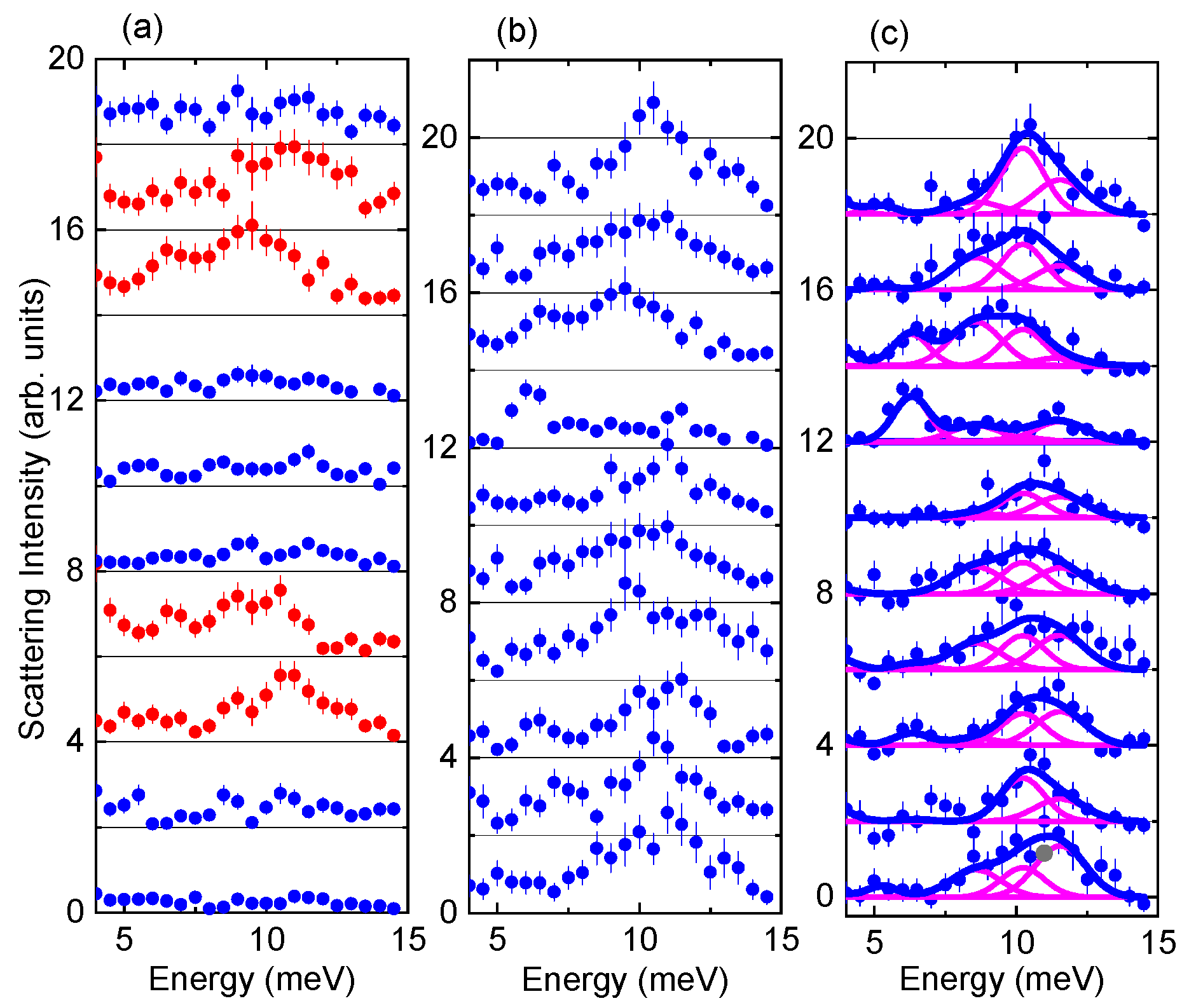
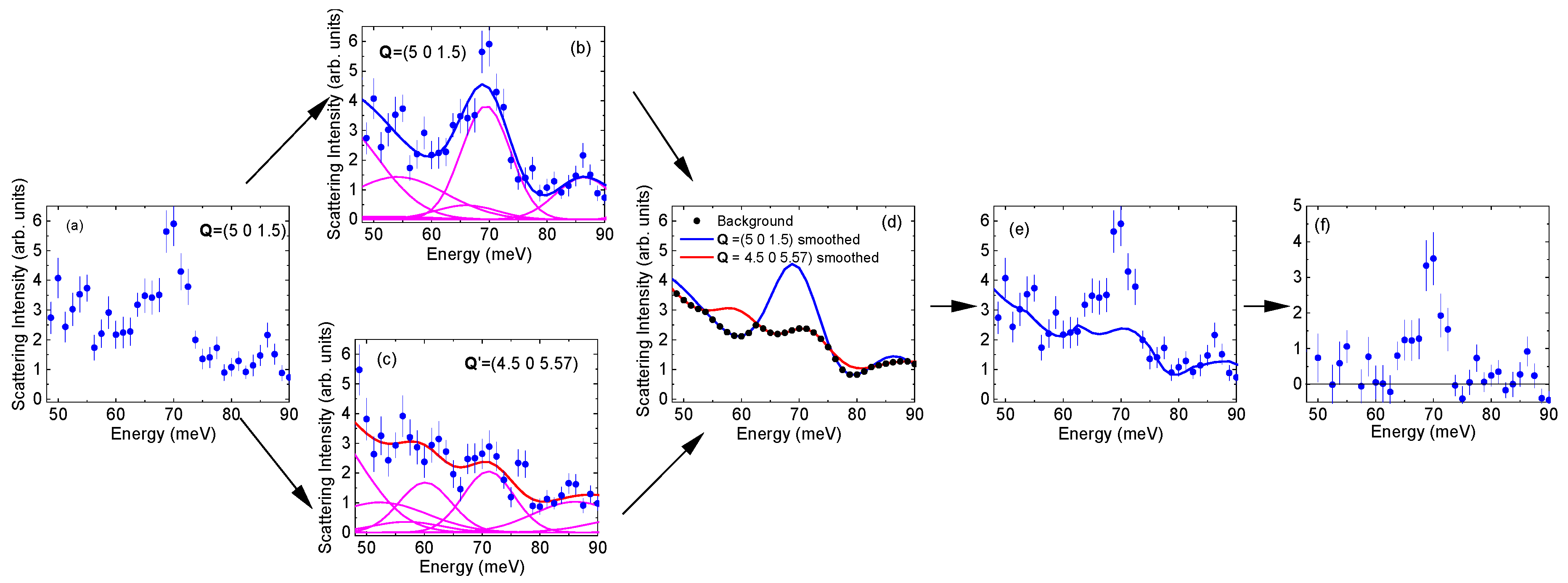
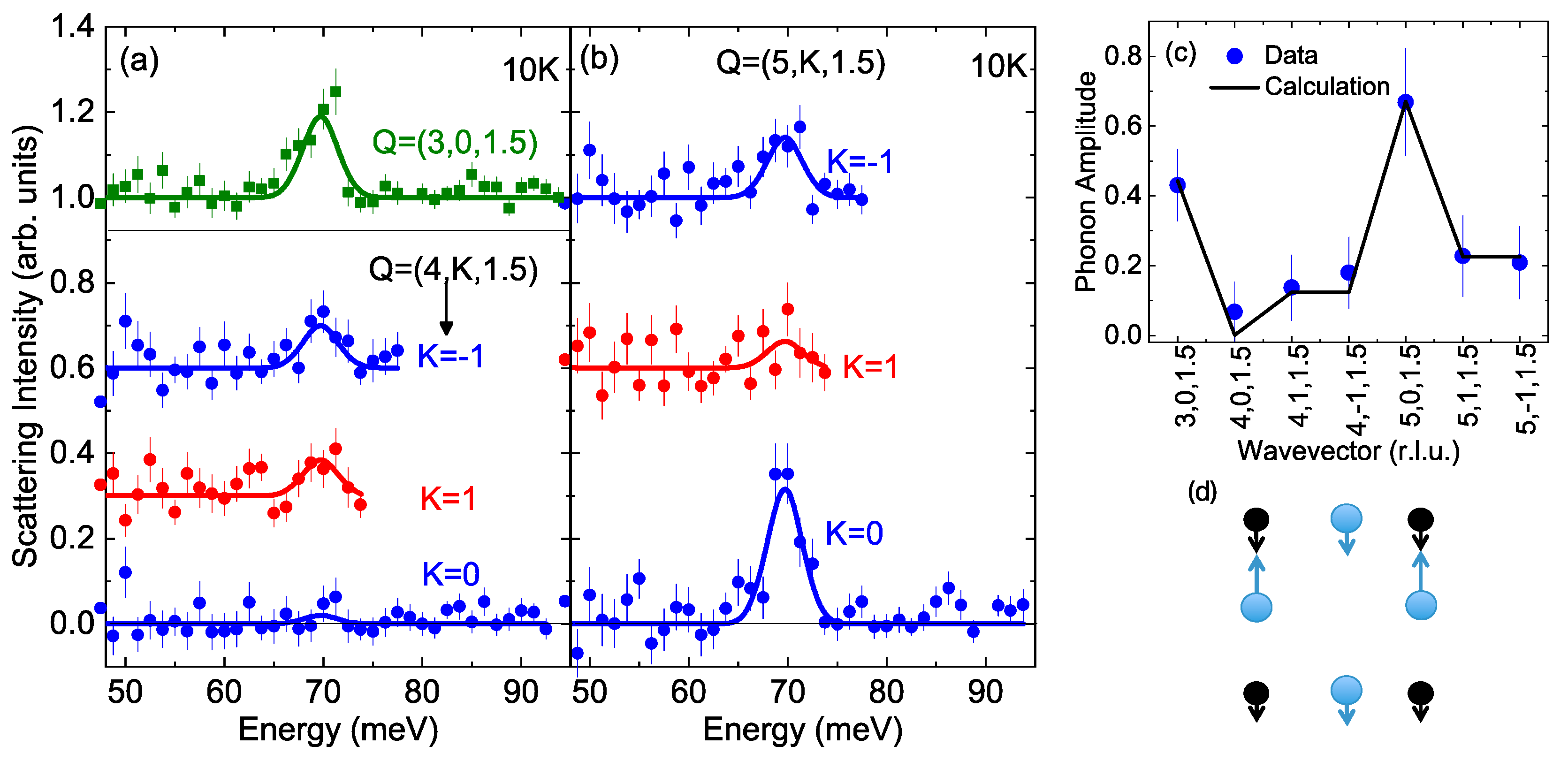
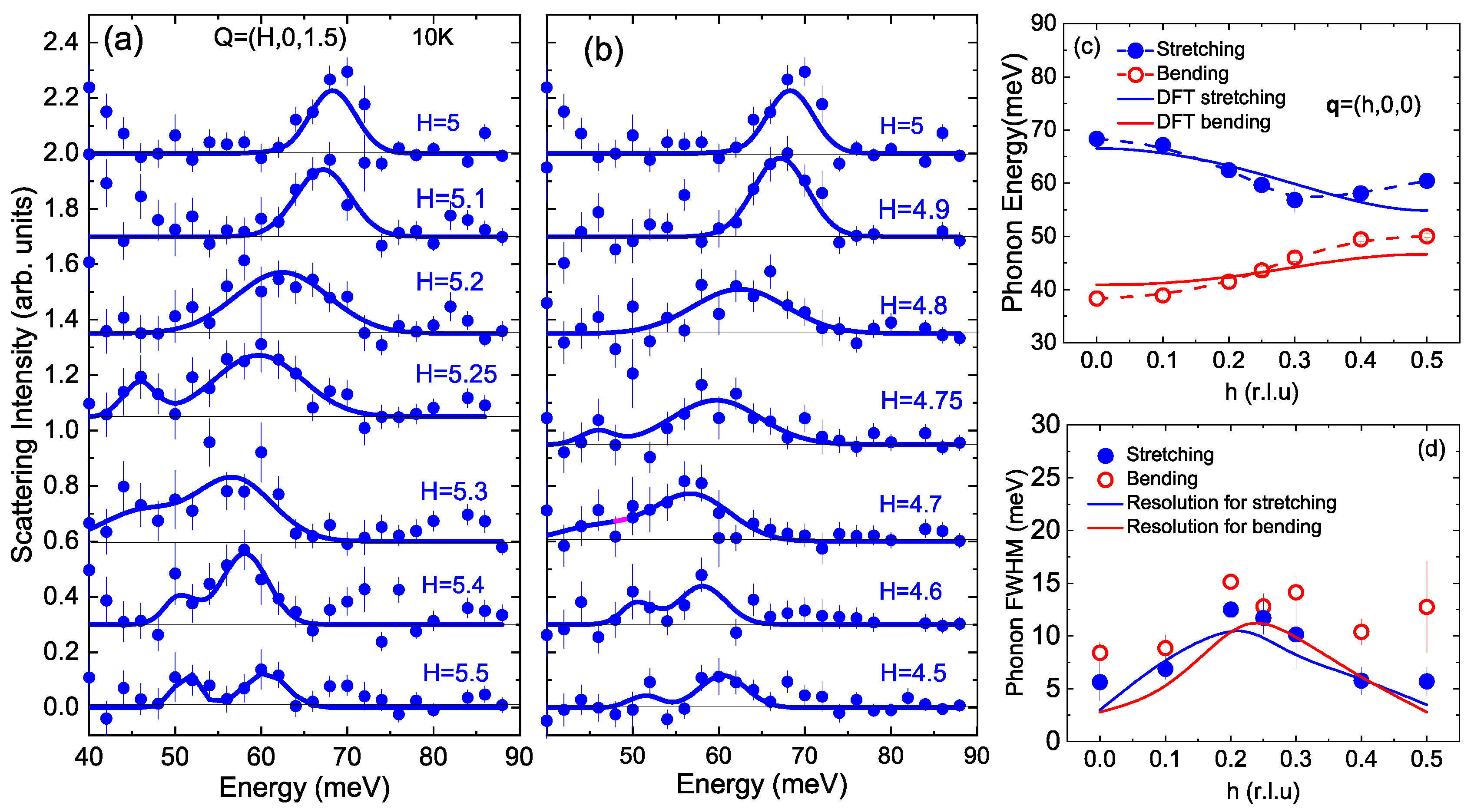
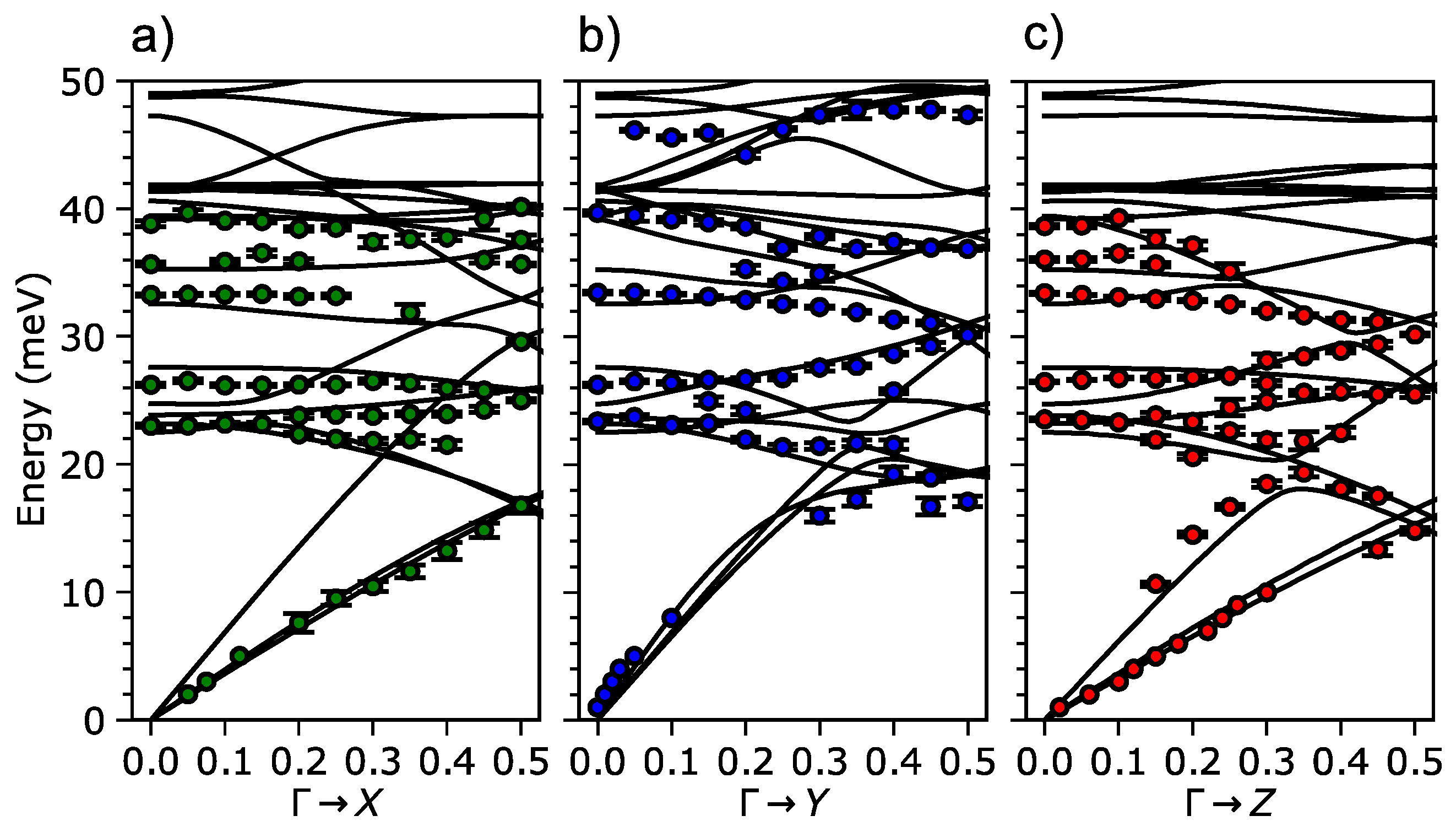
Publisher’s Note: MDPI stays neutral with regard to jurisdictional claims in published maps and institutional affiliations. |
© 2020 by the authors. Licensee MDPI, Basel, Switzerland. This article is an open access article distributed under the terms and conditions of the Creative Commons Attribution (CC BY) license (http://creativecommons.org/licenses/by/4.0/).
Share and Cite
Reznik, D.; Ahmadova, I. Automating Analysis of Neutron Scattering Time-of-Flight Single Crystal Phonon Data. Quantum Beam Sci. 2020, 4, 41. https://doi.org/10.3390/qubs4040041
Reznik D, Ahmadova I. Automating Analysis of Neutron Scattering Time-of-Flight Single Crystal Phonon Data. Quantum Beam Science. 2020; 4(4):41. https://doi.org/10.3390/qubs4040041
Chicago/Turabian StyleReznik, Dmitry, and Irada Ahmadova. 2020. "Automating Analysis of Neutron Scattering Time-of-Flight Single Crystal Phonon Data" Quantum Beam Science 4, no. 4: 41. https://doi.org/10.3390/qubs4040041



